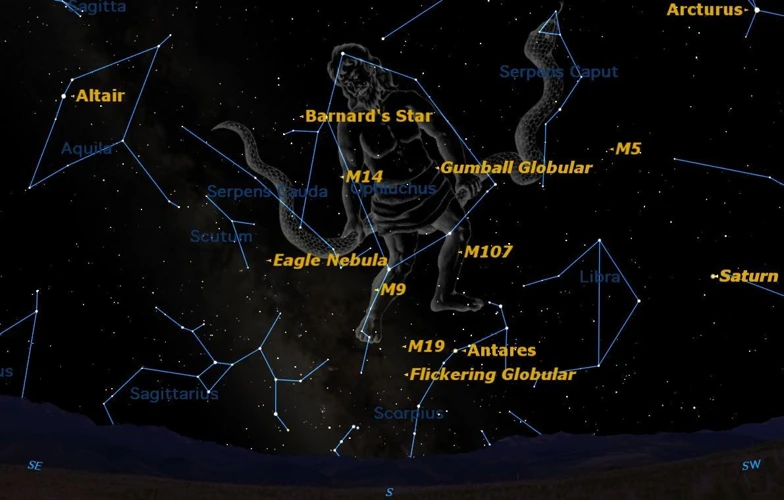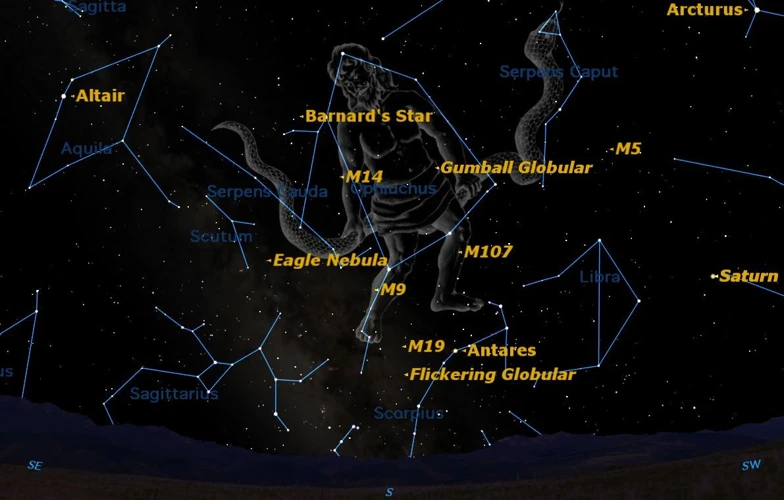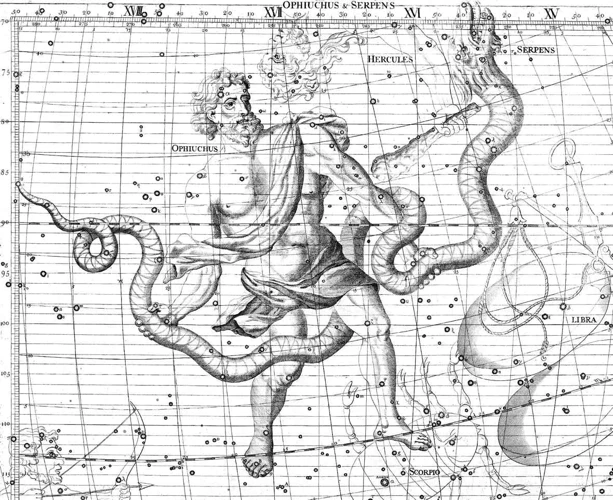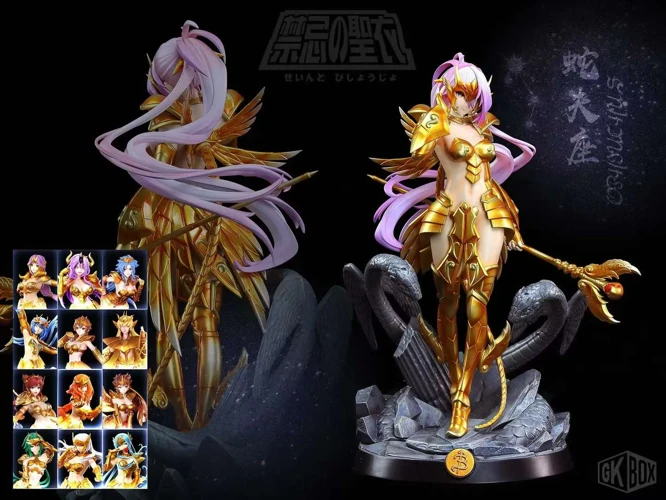The night sky has always captivated our imagination, with its infinite expanse of stars and the tales of gods and heroes that dance across its canvas. Among the many constellations that adorn our celestial sphere, Canis Major and Canis Minor shine brightly, as steadfast companions in the mythological narratives of ancient civilizations. These two constellations tell the stories of great chases, mythical creatures, and celestial guardians. In this article, we will delve into the rich and fascinating narratives behind Canis Major and Canis Minor, exploring their origins, their place in the night sky, and the symbolism and significance they hold in various cultures. Prepare to be enthralled by the furious chase of these mythological constellations.
Contents
- The Story of Canis Major
- The Tale of Canis Minor
- The Symbolism and Significance
- Conclusion
-
Frequently Asked Questions
- 1. What is the significance of Canis Major and Canis Minor in mythology?
- 2. Who is Canis Major associated with in Greek and Roman mythology?
- 3. What is the story behind the Pursuit of Lepus in Canis Major?
- 4. What is the main star in Canis Major?
- 5. What does the name Canis Major mean?
- 6. What is the celestial placement of Canis Major and Canis Minor?
- 7. Is Canis Minor associated with any mythological figure?
- 8. What is the chase in Canis Minor involving Monoceros about?
- 9. Are Canis Major and Canis Minor connected in any way?
- 10. How do different cultures interpret Canis Major and Canis Minor?
- References
-
Frequently Asked Questions
- 1. What is the mythological significance of Canis Major and Canis Minor?
- 2. How did Canis Major come into existence?
- 3. What was Canis Major’s pursuit in mythology?
- 4. How was Canis Major positioned in the night sky?
- 5. What are the mythological origins of Canis Minor?
- 6. What was Canis Minor chasing in mythology?
- 7. How did Canis Minor find its place in the celestial sphere?
- 8. What is the symbolism behind Canis Major and Canis Minor being celestial guardians?
- 9. How does the hunt continue in the mythological narrative of Canis Major and Canis Minor?
- 10. How have different cultures interpreted Canis Major and Canis Minor?
- References
- Read More
The Story of Canis Major

In the captivating tale of Canis Major, we are introduced to an ancient mythological narrative that has been passed down through generations. The Origins of Canis Major can be traced back to Greek and Roman mythology, where it is believed to represent the loyal hound of Orion, the great hunter. According to the myth, Canis Major was a fierce and powerful dog, blessed with incredible speed and strength. It is said that Canis Major was tasked with protecting Orion on his many quests and adventures. The constellation’s name itself translates to “Greater Dog,” emphasizing its significance as a faithful companion and guardian. One of the most famous stories associated with Canis Major is the Pursuit of Lepus. In this story, Canis Major relentlessly chases a rabbit named Lepus across the night sky, symbolizing the eternal struggle between predator and prey. This epic chase is depicted in the constellation, with Canis Major appearing as a loyal and determined canine, forever locked in pursuit of its elusive target. Canis Major’s placement in the night sky is also of great importance, as it can be easily identified by its brightest star, Sirius, which is also the brightest star in the entire celestial sphere. The story of Canis Major is one filled with adventure, loyalty, and the enduring spirit of the hunt.
1. The Origins of Canis Major
The origins of Canis Major can be traced back to ancient Greek and Roman mythology, where it is closely associated with the great hunter, Orion. According to the myth, Canis Major represents the loyal hound of Orion, who accompanied him on his legendary hunting expeditions. The constellation’s name itself, Canis Major, translates to “Greater Dog,” emphasizing its significance as a faithful and powerful companion. In Greek mythology, it is believed that Canis Major was a fierce and mighty dog gifted with extraordinary attributes such as incredible speed and strength. Canis Major served as a protector and guardian, watching over Orion and aiding him in his quests and adventures.
The story of Canis Major and its connection to Orion has been passed down through generations, becoming an integral part of celestial folklore. The mythology behind Canis Major not only symbolizes the loyal bond between human and animal but also reflects the ideals of bravery, strength, and companionship. The constellation’s prominent placement in the night sky further adds to its significance, with its brightest star, Sirius, shining brightly as the “Dog Star”. This brilliant star holds cultural significance across various civilizations and is associated with concepts such as rebirth, luck, and guidance. The tale of Canis Major’s origins is a testament to the enduring power of myth and its ability to capture the essence of human experiences and beliefs. To learn more about the cultural significance of constellations, you can read our article about the cultural significance of the constellation Cygnus.
2. The Pursuit of Lepus
The Pursuit of Lepus is a captivating episode within the mythological narrative of Canis Major. In this story, Canis Major is depicted as a relentless hunter, forever chasing the elusive Lepus, the rabbit. The pursuit of Lepus symbolizes the eternal struggle between predator and prey, highlighting the fierce determination and agility of Canis Major. The constellation Canis Major beautifully portrays this chase, with its stars forming the shape of a dog in full stride, its head turned towards the rabbit. Canis Major’s brightest star, Sirius, is often associated with the watchful eye of the determined hunter. The story of the pursuit of Lepus serves as a reminder of the constant pursuit of goals, the unyielding determination to overcome obstacles, and the relentless pursuit of our desires. It teaches us the importance of persistence and resilience in the face of challenges. The pursuit of Lepus is a timeless tale that continues to inspire and remind us of the power of perseverance and dedication in our own lives.
3. The Placement in the Night Sky
The placement of Canis Major in the night sky holds a significant role in its mythological narrative. Located near the celestial equator, Canis Major is easily visible from both the northern and southern hemispheres, making it one of the most recognizable constellations in the night sky. Its prominent position allows observers to trace the constellation’s distinctive shape. Canis Major is bordered by several other well-known constellations, including Orion, Gemini, and Puppis. One of the standout features of Canis Major is its brightest star, Sirius, also known as the Dog Star. Sirius is not only the brightest star in Canis Major but also the brightest star in the entire night sky, adding to the constellation’s prominence. This brilliant star has attracted the attention and imagination of humans throughout history, inspiring countless stories, legends, and cultural interpretations. The positioning and visibility of Canis Major have played a crucial role in its recognition and relevance across various civilizations and cultures, solidifying its place among the celestial wonders that continue to captivate our hearts and minds.
The Tale of Canis Minor

In the enchanting tale of Canis Minor, we uncover another captivating mythological narrative woven into the fabric of our celestial tales. Canis Minor’s Mythological Origins can be traced back to ancient Greek and Roman mythology, where it is said to depict a smaller companion to Canis Major. Canis Minor is commonly associated with the figure of Maera, a loyal hunting dog who belonged to Icarius, a legendary Athenian wine-maker. In one version of the myth, Icarius was tragically killed, and Maera, overcome with grief, leaped into his funeral pyre to join him in the afterlife. As a reward for her loyalty, the gods immortalized Maera as a constellation, forever shining brightly in the night sky. The Chase for Monoceros is another captivating story associated with Canis Minor. In this tale, Canis Minor engages in a thrilling pursuit of Monoceros, a mythical creature with the body of a horse and the tail of a serpent. This chase represents the eternal struggle between predator and prey, showcasing Canis Minor’s determination and agility. Canis Minor finds its place in the celestial sphere near its brighter companion, Canis Major, serving as a reminder of the bond between loyal comrades. Though smaller in size, Canis Minor shines with its own unique story and symbolism, captivating stargazers with its tales of loyalty and the pursuit of mythical creatures.
1. Canis Minor’s Mythological Origins
Canis Minor, the smaller celestial companion to Canis Major, also holds its own intriguing mythological origins. In ancient Greek mythology, Canis Minor’s Mythological Origins are often associated with the story of the famed musician Orpheus. According to the myth, Orpheus possessed unparalleled musical talent, capable of enchanting all who heard his melodies. However, tragedy struck when his beloved wife, Eurydice, was bitten by a venomous snake and passed away. Overwhelmed with grief, Orpheus ventured into the underworld to rescue his beloved. It is during this perilous journey that Canis Minor enters the narrative. As Orpheus descended into the realm of Hades, he was accompanied and protected by his loyal and devoted dog, represented by Canis Minor. This faithful canine companion aided him in navigating the treacherous paths of the underworld and served as his guide and protector. Canis Minor’s association with loyalty and companionship is highlighted in this myth, showcasing its significance as a symbol of unwavering loyalty and steadfast support. This mythological tale infuses Canis Minor with a sense of devotion and exemplifies the bond between humans and canines, immortalized in the stars above.
2. The Chase for Monoceros
In the mythological narrative of Canis Minor, we encounter the thrilling story of The Chase for Monoceros. Canis Minor, also known as the “Lesser Dog,” embarks on an epic pursuit of the mythical creature known as Monoceros, or the Unicorn. According to ancient legends, Monoceros was a majestic beast with a single horn on its forehead, symbolizing purity and grace. Canis Minor, fueled by its relentless determination and loyalty, sought to capture the elusive Unicorn and prove its worth as a faithful companion. The chase between Canis Minor and Monoceros is depicted in the constellation, with Canis Minor appearing as a small dog in constant pursuit of the magnificent Unicorn. This celestial representation immortalizes the eternal struggle between predator and prey, highlighting the innate instinct and drive within Canis Minor. The story of the chase for Monoceros serves as a reminder of the enduring spirit of pursuit and the pursuit of noble goals. It embodies the qualities of courage, perseverance, and unwavering loyalty that Canis Minor represents. Just as the mythological narrative unfolds in the night sky, the chase for Monoceros in Canis Minor continues to inspire and captivate us with its symbolism and timeless message of determination and pursuit.
3. Finding a Place in the Celestial Sphere
Finding a place in the celestial sphere is a significant aspect of any constellation’s story, and Canis Major is no exception. The constellation Canis Major is prominent in the southern hemisphere and can be easily identified by its brightest star, Sirius. Sirius, also known as the Dog Star, holds immense cultural and symbolic importance in various civilizations. Ancient Egyptians revered Sirius as a bringer of new beginnings, as its annual rising coincided with the flooding of the Nile, marking the start of a new agricultural cycle. In Greek mythology, Sirius was associated with the dog of Orion, the hunter. The placement of Canis Major and its bright star Sirius in the celestial sphere has made it a crucial navigational marker throughout history. Sailors relied on Sirius to navigate their ships, as its position in the night sky provided an anchor point from which they could determine their direction. Additionally, Canis Major’s position close to the celestial equator allows it to be visible from many parts of the world, further solidifying its prominence. The celestial positioning of Canis Major and the bright star Sirius make it a stellar guide and a prominent figure in the tapestry of the night sky.
The Symbolism and Significance

The symbolism and significance of Canis Major and Canis Minor are deeply woven into the fabric of ancient cultures and mythological beliefs. As celestial guardians, these constellations hold immense power and represent various themes. Celestial Guardians: Canis Major and Canis Minor are often seen as loyal protectors of the night sky, serving as guides and companions to the celestial figures they are associated with. Their presence symbolizes watchfulness, loyalty, and courage. The Hunt Continues: The mythological narratives of Canis Major and Canis Minor demonstrate the eternal pursuit and unyielding determination of their characters. This relentless chase reflects human desires, aspirations, and the pursuit of goals and dreams. It serves as a reminder that the pursuit itself is often as valuable as the end result. Cultural Interpretations: Throughout history, Canis Major and Canis Minor have been interpreted differently by various cultures. In Egyptian mythology, Canis Major is associated with the god Anubis, the guardian of the dead and the underworld. In Greek and Roman mythology, these constellations are closely tied to the stories of Orion, contributing to his heroic status. The symbolism and significance of these constellations have permeated art, literature, and various cultural traditions, showcasing their enduring influence.
1. Celestial Guardians
In the realm of mythology, Canis Major and Canis Minor hold a significant role as celestial guardians. These constellations have been depicted as faithful companions to gods and heroes throughout various cultures. As 1. celestial guardians, they are believed to watch over the heavens and protect the celestial realm from harm. In Greek mythology, Canis Major is often associated with Orion, the mighty hunter, while Canis Minor is linked to his hunting partner, the legendary hunter known as Lynx. These loyal dogs are said to accompany their respective heroes in their quests and adventures, offering their unwavering loyalty and strength. Canis Major and Canis Minor stand as symbols of devotion and protection, representing the unwavering bond between humans and animals. Their presence in the night sky serves as a reminder of the guardianship and companionship that exists between the mortal and the divine. These constellations, with their fierce and noble representations, continue to inspire awe and wonder, reminding us of the importance of loyalty and protection.
2. The Hunt Continues
In the mythological narrative of Canis Major and Canis Minor, the hunt continues with unwavering determination. In , we explore the ongoing pursuit of their respective targets and the symbolism behind this relentless chase.
For Canis Major, the hound of Orion, the hunt continues as it relentlessly pursues Lepus the rabbit across the night sky. This chase symbolizes the eternal struggle between predator and prey, highlighting the primal instinct ingrained in nature. Canis Major embodies loyalty, strength, and determination, never ceasing in its pursuit, representing the fierce spirit of the hunt.
Likewise, Canis Minor, the smaller companion of Canis Major, embarks on its own chase. This time, it is in pursuit of Monoceros, the mythical unicorn. Canis Minor is depicted as a faithful companion to Canis Major, aiding in the pursuit with its unwavering loyalty. The hunt for Monoceros is a symbol of the pursuit of the unattainable, of chasing dreams and aspirations that seem out of reach.
These stories of continued pursuit in Canis Major and Canis Minor remind us of the human desire to chase our passions and dreams, to never give up in the face of adversity. They inspire us to persevere, even when the target seems elusive. The constellations serve as a timeless reminder that the hunt continues, and it is through perseverance and determination that we may ultimately find fulfillment and success in our own pursuits.
To delve deeper into the symbolism and meaning behind the constellation Canis Minor, you can explore the role of Ophiuchus in art and visual representations, shedding light on the interconnectedness of these mythological narratives and their cultural significance.
3. Cultural Interpretations
Cultural Interpretations
Cultural interpretations of Canis Major and Canis Minor vary across different civilizations and time periods. In ancient Egypt, Canis Major was associated with the god Anubis, the jackal-headed deity who presided over the afterlife. Anubis was believed to guide the souls of the deceased through the perilous journey of the underworld, much like Canis Major guided Orion in his quests. The constellation also held significance in Mayan mythology, where it was associated with the god Xolotl, who was often depicted as a dog-headed companion of the Sun. In Greek mythology, Canis Major was sometimes linked to Maera, a faithful hound who tragically died alongside her owner, Icarius. The Greeks also associated Canis Minor with the hunting dog of the legendary hunter Actaeon, who was transformed into a stag and subsequently torn apart by his own hounds as punishment for glimpsing the goddess Artemis bathing. These cultural interpretations highlight the diverse ways in which different societies have found meaning and symbolism in these constellations, weaving them into their own mythological tapestries. The stories of loyalty, protection, and the eternal chase have resonated with cultures throughout history, leaving their mark on art, literature, and folklore. Understanding the cultural interpretations of Canis Major and Canis Minor allows us to appreciate the enduring significance of these constellations across time and civilizations.
Conclusion

In , the tales of Canis Major and Canis Minor reveal a rich tapestry of mythological narratives and celestial symbolism. These constellations have fascinated and inspired cultures throughout history, serving as celestial guardians and embodying the eternal pursuit of prey. Canis Major, with its origins as Orion’s loyal hound, showcases the unwavering loyalty and strength of a faithful companion. The pursuit of Lepus symbolizes the never-ending chase, highlighting the primal instinct of predator and prey. Canis Minor, on the other hand, finds its mythological origins in stories of divine companions and relentless hunters, leading the chase for Monoceros. Both constellations find their place in the celestial sphere, visible to stargazers and serving as reminders of the vastness and wonder of the cosmos. The symbolism and significance of Canis Major and Canis Minor extend beyond ancient mythology into the realm of cultural interpretations, where different civilizations have added their own unique perspectives and stories to these constellations. Whether seen as celestial protectors, reminders of the cycle of life and death, or symbols of bravery and loyalty, the stories behind Canis Major and Canis Minor continue to captivate our imagination and connect us to the ancient traditions of our ancestors. As we gaze up at the night sky, we are reminded of the enduring power of myth and the beauty of the celestial realm.
Frequently Asked Questions

1. What is the significance of Canis Major and Canis Minor in mythology?
Canis Major and Canis Minor hold great significance in mythology as they are associated with the stories of loyal companions and celestial guardians.
2. Who is Canis Major associated with in Greek and Roman mythology?
In Greek and Roman mythology, Canis Major is associated with Orion, the great hunter, and is believed to be his loyal hunting dog.
3. What is the story behind the Pursuit of Lepus in Canis Major?
The Pursuit of Lepus is a famous mythological story within Canis Major, where the constellation represents a dog relentlessly chasing a rabbit named Lepus across the night sky, symbolizing the eternal struggle between predator and prey.
4. What is the main star in Canis Major?
The main star in Canis Major is Sirius, also known as the “Dog Star.” It is the brightest star in the night sky and holds great significance in various cultures around the world.
5. What does the name Canis Major mean?
The name “Canis Major” translates to “Greater Dog,” emphasizing the constellation’s representation of a faithful and powerful canine companion.
6. What is the celestial placement of Canis Major and Canis Minor?
Canis Major and Canis Minor are both located in the southern celestial hemisphere and can be seen from various parts of the world, depending on the season and time of year.
7. Is Canis Minor associated with any mythological figure?
Yes, in Greek and Roman mythology, Canis Minor is associated with Maera, a loyal hunting dog who accompanied the hero Icarius.
8. What is the chase in Canis Minor involving Monoceros about?
The chase in Canis Minor involves the constellation pursuing Monoceros, a mythical creature with the body of a horse and the tail of a unicorn. It showcases the eternal pursuit of a mythical being.
9. Are Canis Major and Canis Minor connected in any way?
While Canis Major and Canis Minor are separate constellations, they are often depicted as hunting companions, both symbolizing loyalty and the pursuit of their respective targets.
10. How do different cultures interpret Canis Major and Canis Minor?
Canis Major and Canis Minor have been interpreted differently across various cultures, showcasing themes of loyalty, hunting, and the celestial guardianship of the night sky. Some cultures also associate these constellations with specific gods or heroes.
References
Frequently Asked Questions

1. What is the mythological significance of Canis Major and Canis Minor?
Canis Major and Canis Minor hold mythological significance as celestial figures in various ancient cultures. They are often associated with stories of pursuit and chase, symbolizing the eternal struggle between predator and prey.
2. How did Canis Major come into existence?
According to mythology, Canis Major originated from the story of Laelaps, a hound gifted with incredible speed. Laelaps was later placed among the stars by the gods and became Canis Major, forever chasing its prey.
3. What was Canis Major’s pursuit in mythology?
In mythology, Canis Major was known for its relentless pursuit of Lepus, the hare constellation. The chase depicted in the stars symbolizes the eternal struggle between the hunter and the hunted.
4. How was Canis Major positioned in the night sky?
Canis Major was placed in the night sky as a faithful companion to Orion, the legendary hunter. The constellation is often depicted by a dog following Orion, eternally in pursuit of its prey.
5. What are the mythological origins of Canis Minor?
Canis Minor’s mythological origins can be traced back to ancient Greek mythology. It is believed to represent Maera, a loyal dog who accompanied Prince Alcyoneus and was later transformed into a constellation to forever chase Monoceros, the unicorn.
6. What was Canis Minor chasing in mythology?
In mythology, Canis Minor was in constant pursuit of Monoceros, the elusive unicorn constellation. The chase represented the everlasting hunt for the mystical and unattainable.
7. How did Canis Minor find its place in the celestial sphere?
Canis Minor found its place in the celestial sphere when Maera, the faithful dog, was immortalized in the stars. Positioned close to Canis Major and Orion, Canis Minor continues its eternal chase for Monoceros.
8. What is the symbolism behind Canis Major and Canis Minor being celestial guardians?
Canis Major and Canis Minor, as celestial guardians, symbolize the never-ending cycle of life, death, and rebirth. They represent the perpetual watchfulness and protection over the celestial realm.
9. How does the hunt continue in the mythological narrative of Canis Major and Canis Minor?
The hunt depicted in the mythological narrative of Canis Major and Canis Minor symbolizes the ongoing pursuit of dreams, desires, and aspirations. It represents the human need for perseverance and dedication in the face of challenges.
10. How have different cultures interpreted Canis Major and Canis Minor?
Various cultures have interpreted Canis Major and Canis Minor differently. Some see them as the embodiment of loyalty and devotion, while others associate them with the concept of never giving up in the pursuit of one’s goals. The interpretations often reflect cultural beliefs and values.







